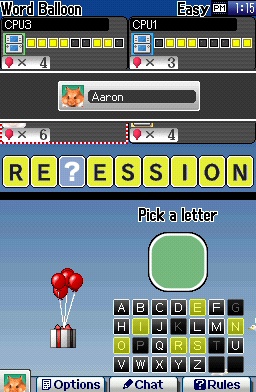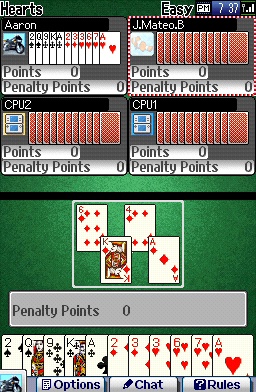Board games, card decks, and sets of dice take up a ton of physical space and are a real pain in the behind to drag down out of the closet, but they sure are loads of fun to play when your buddies are over. Drink some beverages, break out the pretzels, and have a grand old time into the wee hours. Clubhouse Games for the Nintendo DS eliminates all of that storage space and prep-work hassle. It packs 42 different parlor games into a single DS cartridge and lets you play them alone or against your friends, whether they're in the same room with you or chilling out in their own homes across town.

The diverse selection of games includes both popular and esoteric standbys. There are 18 different card games, broken down into basic, intermediate, and advanced categories. Basic card games include Old Maid, Spit, I Doubt It, Sevens, Memory, and Pig. Intermediate card games include Blackjack, Hearts, President, Rummy, Seven Bridge, Last Card, and Last Card Plus. Advanced card games include Five Card Draw Poker, Texas Hold 'Em, Nap, Spades, and Contract Bridge. Next up, there are 12 different board games, which are split into basic and advanced categories. Basic board games include Checkers, Chinese Checkers, Dots and Boxes, Hasami Shogi, Reversi, Connect Five, and Grid Attack. The advanced lineup includes Backgammon, Chess, Shogi, Field Tactics, and Ludo. Also included are nine different variety and action games, including Soda Shake, Dominoes, Koi-Koi, Word Balloon, Balance, Billiards, Bowling, Darts, and Takeover. Rounding out the list are three single-player games: Solitaire, Mahjong, and a slide puzzle game called Escape.
Don't see your favorite game on the list? It could be hiding there under an alias. For instance, the popular schoolyard game "Bulls***" is listed under its politically correct title, I Doubt It. Other examples include Grid Attack, better known as "Battleship"; Word Balloon, which is a nice name for "Hangman"; Last Card Plus, a standard deck version of "Uno"; and President, which many a giggling child first learns as "A-Hole." The lineup is so diverse that everyone is pretty much guaranteed to find a few games to enjoy. The best part is that the majority of games in the collection let multiple players compete, either by linking multiple systems together or by logging into Nintendo's Wi-Fi Connect online service. The only exceptions are the single-player games and a couple of the basic card games.
What's especially great is that the whole product, from top to bottom, is put together in such a way that anyone, regardless of age or amount of video game experience, can just jump in and begin playing. The majority of games follow the same rules as their real-life counterparts, so you probably already know how to play many of them. For the games you are not familiar with, rulebooks are just a single tap away. The graphics and audio are very plain, but the upside to the no-nonsense table depictions and cheesy lounge music is that everything is neatly organized and easy to see. When you're not in a game, instructions are displayed on the upper screen, while interactive menus and buttons are situated on the touch-sensitive bottom screen. When you're playing a game, the upper screen shows the game board or table, while the lower screen shows your cards or pieces and lets you manipulate them by using the stylus. It's all very accessible. Laying down cards and manipulating pieces is always a simple matter of tapping and dragging onscreen objects with the stylus. For action games, such as darts, billiards, and bowling, you grab onto the dart, stick, or ball by touching them with the stylus and let them fly by quickly flicking and lifting the stylus away. Simple animations show the objects sailing across the screen. Obviously, physical games played in this fashion don't pack as many thrills as their real-life counterparts, but the video renditions are still enjoyable.

All of the games are generally as you remember them, although some of the card games have been streamlined in the interest of saving time. You can't split in Blackjack, for example, and betting in Texas Hold 'Em has a fixed limit. If you had dreams of yelling out "All in!" like Johnny Chan, well, you'll have to settle for "Sixty bucks!" The most controversial changes concern the implementation of hand limits and negative bankrolls. To make a long story short, you can continue to play when you're in the negative, and games end after a set number of hands, as opposed to continuing until everyone is eliminated. The games are still fun despite these changes, but there's no denying that some of the tension is lost when people can bet from the red, and chip leaders can fold their way to wins. It's worth repeating, though, that these changes apply only to specific card games. Anyone who is looking for a great Poker game or a great Blackjack game won't find it here, but when you consider that this is a collection of 42 different games, the renditions included in Clubhouse Games are more than enough.
On your own, you can expect to kill quite a lot of time futzing around with all of the various games. For games that allow you to compete against multiple opponents, you can generally specify the number of CPU-controlled bots. As far as the CPU's play is concerned, it rolls over on the easy/difficult setting and presents a competent challenge on the higher settings. Advanced games, such as Chess and Texas Hold 'Em, are still a little too advanced for the CPU, which means that seasoned players shouldn't have any trouble besting their computer opponents. Those games are the exceptions, however, rather than the norm.
Single-player modes include free play, stamp, and mission. In the stamp mode, you earn stamps for beating the CPU at each game in the collection. The mission mode, meanwhile, contains a number of time- and score-based challenges that are oriented around all of the various games. Your reward for collecting stamps and completing missions is a bunch of new avatars and table color schemes, as well as the ability to access a couple of games that are locked away from the start.
Solo play is nice, but where Clubhouse Games truly shines is in regard to its multiplayer features. Playing against other people introduces the human element that makes simple games like these so addictive. Even the card games that have had their rules changed to encourage turtling tend to get crazy when other people are involved, especially if those other people are your so-called friends. Thirty-seven of the 42 included games support multiplayer play, either in one-on-one fashion or with groups of up to eight players. A pop-up Pictochat-style interface lets everyone send messages back and forth while playing.

You and your friends can link multiple DS systems together from the same room, or you can meet up with people online using Nintendo's Wi-Fi Connect service. To get a group going in the same room, you need only a single copy of Clubhouse Games. The person with the cartridge can beam individual games to everyone else. The process takes only a few seconds, and everyone ends up with the full experience (the same graphics, the same music, and so on). If you go online, you can organize games with people on your friends list or challenge random players in the worldwide mode. There are already loads of people playing online, so much so that jumping into a game with strangers usually takes only about 30 seconds. Leaderboard rankings are tracked for every game, and the system even maintains a separate leaderboard for you and your friends. Disconnects are handled in a democratic fashion. When a player quits, he or she is replaced by a CPU player. As long as you play through to the end, you'll be credited for your performance. The only lame thing about the online experience is that Nintendo's Wi-Fi Connect safeguards make it impossible to invite strangers to join your friends list and limit the chat messages you can exchange in worldwide games to preset phrases.
Clubhouse Games is a perfect example of what Nintendo is trying to accomplish with its Touch Generations initiative. It packs 42 different games that many people are already familiar with onto a single cartridge and makes them accessible to anyone who can figure out how to tap the screen and drag the stylus. Some of the games included in the collection aren't the best renditions, but there are plenty of them, especially when you consider how many games you get for the purchase price. On top of that, you can play against your friends, whether they're in the same room or across town. It's like having access to your grandparents' game closet everywhere you go.